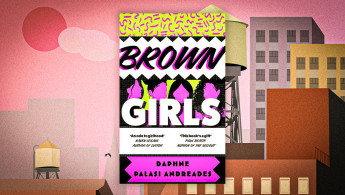Brown Girls: Navigating the challenges of life as a woman of colour today
Daphne Palasi Andreades’ debut novel Brown Girls is a vibrant, emotive account of what it means to navigate life as a woman of colour today.
In the opening chapter of Brown Girls, Andreades sets the scene for what is to become the heartbeat of the novel – the ‘dregs’ of Queens. ‘On our block, a lonely tree grows. Its branches tangle in power lines. Its roots upend side-walks where we ride our bikes before they are stolen. Roots that render the concrete slabs uneven, like a row of crooked teeth,’ writes Andreades. An urban setting, rough around the edges but rich in culture.
Although largely plotless, the novel follows the lives of a group of young women from immigrant families living in Queens, New York. As their stories unfold in a series of short vignettes, Queens is always in the foreground, whether in the tension felt among locals as the women bring ‘white boys’ to visit their neighbourhood, or in the depiction of a chance for a new life as told through the eyes of their immigrant families.
|
What stands out the most in Andreades’ writing is the collective narrative voice of the novel, which she executes beautifully.
‘We take our white boys to our home turf. From subways we watch high-rises transform to squat buildings and bodegas. We point out city hospitals – Elmhurts, Jamaica, Woodhull — where we were born, where some of our parents work as janitors, aides, nurses, social workers, paper pushers.’
Her writing flows with the same fast pace you’d expect of life in the city, it’s lyrical in tone.
This collective authentic voice is used to successfully illustrate the many common setbacks and challenges faced by the community of people it represents – while simultaneously refraining from painting all people of colour as the same. She weaves languages such as Urdu, Portuguese, and Vietnamese into the novel and adds colour to the lives of her characters with accurate nods to their respective cultures.
As the reader is absorbed further into the book, we learn more about the challenges women of colour have to navigate at different stages in life, from school, college, graduating and entering the workforce, starting families (and not starting families), midlife crises and inevitably death and the afterlife.
"In Brown Girls, Andreades manages to write a novel that truly reflects the experiences of women of colour from a diverse group of backgrounds and illustrates the complexities of their life experiences"
Details of the daily microaggressions and casual racism thrown at them by teachers, the parents of their partners, and colleagues. The tragedies that unfold in their lives, some that we all face, like grieving friends who lost their lives too young, and others that come part and parcel of living in impoverished, neglected immigrant communities – brothers who end up in jail despite their dreams of leaving Queens and friends who fail in breaking the generational curses that bind them to a life they don’t want to live.
You start to realise that this book could easily be set in inner-city London or Toronto, it represents a global diaspora of young women with shared lived experiences.
One particularly moving chapter details a trip back to the motherland, to Dhaka, Manila, Kingston, Damascus, Accra, and Tehran. A decision was reached as a result of an ensuing ‘awakening’. The women start to question who they are and where they belong. During their travels, they realise the answer isn’t a simple one.
‘American – is that what we are? We slyly ask our cousins, the ones who tour us around and know these lands in ways we never will. Yes, because you were born in the States, they tell us. Or, No, you have Mexica, Filipino, Guyanese, Panamanian, Indian, Haitian, Chinese blood – how could you be anything else?’
This journey is one shared by third culture kids around the world, and Andreades writes about it with true perspective and thought.
‘All of us have cousins, aunts, uncles, and grandparents who toggle with ease between various dialects and languages, English included. They apologise for their accents, but we don’t care – we are in awe of them and could listen to them speak all day.’
Although it’s true that in recent years we have had the privilege of reading more diverse stories with characters from across cultures and religions, they tend to focus on one culture and tell one story.
In Brown Girls, Andreades manages to write a novel that truly reflects the experiences of women of colour from a diverse group of backgrounds and illustrates the complexities of their life experiences. If you love to read literature exploring the diaspora experience then you will love this book.
Sahar Esfandiari is a British-Iranian writer focused on the Middle East and its diaspora
Follow her on Twitter: @saharesfandiari



